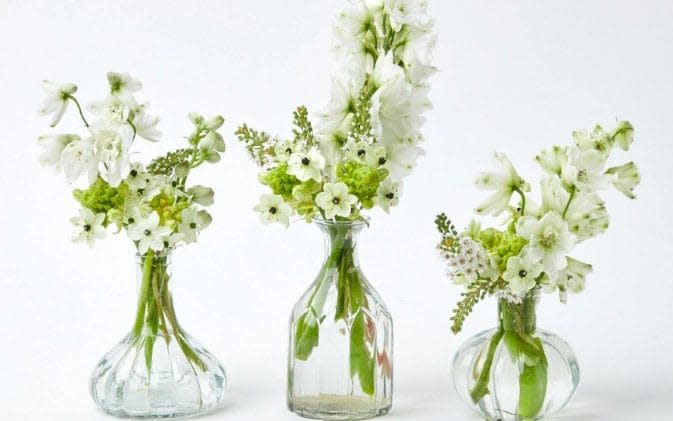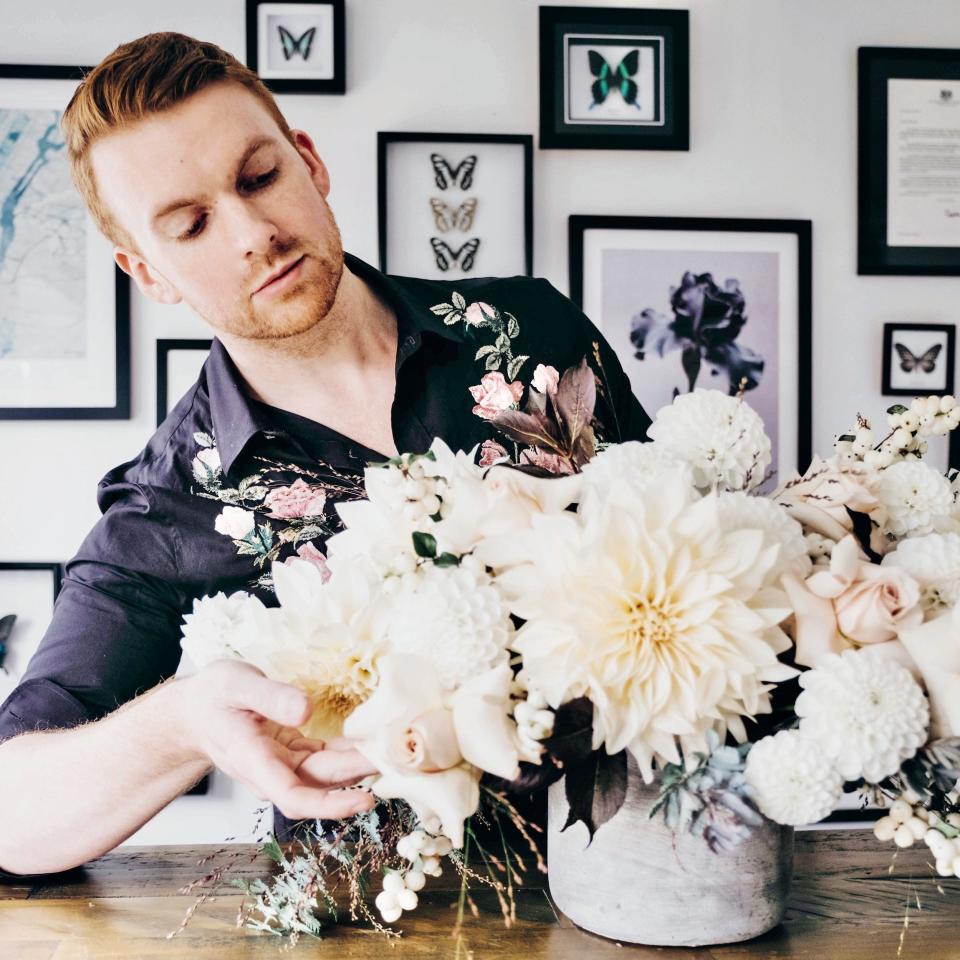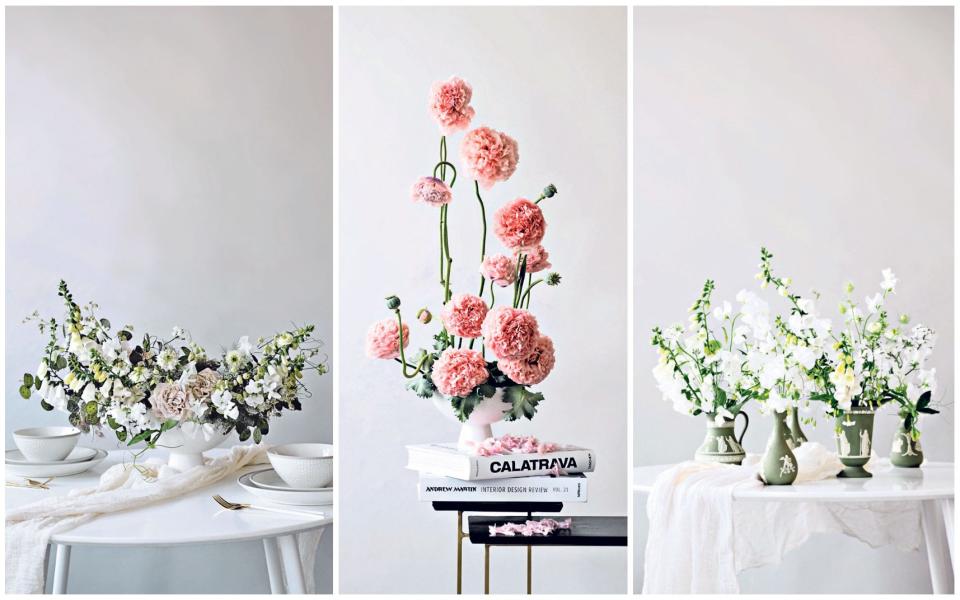How flower arranging got cool again – and three ways to master it

Flower arranging, once viewed as a rather genteel hobby, has rocketed up in the cool stakes in recent years: floral influencers such as Willow Crossley are making floristry fashionable, while pictures of elaborate centrepieces and whimsical romantic arrangements are flooding social media – the hashtag #flowerstagram has more than 36 million posts on Instagram.
While there are many florists jostling to put themselves on the map, Joseph Massie is fast establishing himself as a name to know in the world of floristry. At the age of 34, he has won five consecutive Gold Medals, as well as four Best in Show titles, at the RHS Chelsea Flower Show.
In fact, he is widely regarded as the floral artist of his generation, with customers more than happy to spend a minimum of £5,000 for his sculptural designs. He’s even showcased his artistry at the White House, while the Obamas were in residence.
“That was probably one of the most incredible things I’ve done, especially given where I’m from,” says Massie, who grew up in Huyton, a deprived borough of Liverpool. “I sometimes say I’m like the floral Oliver Twist. I’m from a working-class background where no-one was artistic, or creative. There were no shortcuts. It was very much start at the bottom and work your way up.”

By that, he means working on a flower stall for £2.50 an hour, “where we called roses by their colour, not their name. I was 14 and after a Saturday job. I didn’t care what it was, frankly, and for the first six months, I didn’t even touch a flower – I was scrubbing buckets. But I became fascinated by the subject and wanted to learn everything.”
Eschewing the advice of teachers, who were pushing him down a more academic route, Massie went to work for a florist in Liverpool city centre on leaving school. It was there that he came across an advertisement in an industry magazine that read, “Are you the young florist of the year?”
“I thought, yes, I am, that is me,” he says. “I entered and came fifth. But I was 16, with zero money and zero training, and thought if I’d managed to get that far, I could maybe do all right.” Two years later, he entered again – and won.
“I spent any spare money I had on travelling the country to train with leading florists, and I noticed they all had Chelsea Gold Medals, the pinnacle of the horticultural world,” he says. It’s why his own first Gold Medal, which he won in 2009, remains a highlight of his career.
“I travelled down to London on the train with everything in two big Ikea bags, stayed with a friend of a friend in Peckham, and constructed everything in this random kitchen, before getting a cab to the flower show with the finished piece. It was absolute madness, so to win was insane,” he remarks, shaking his head in disbelief at the memory.

After freelancing for a few years, he opened his own business in Liverpool in 2015, enjoying “five years of amazing trading and then two years of Covid hell. Our clients don’t do small, so it was tough.” He is currently getting back on track, and has a summer full of weddings. Meanwhile, his pandemic-related lull prompted him to try other things. He started a podcast (Flowers After Hours), and also online classes, which have now become a big part of his business.
He also wrote his first book, Flower School: The Principles and Pleasures of Good Flowers, a weighty tome that’s as decorative as the designs it depicts. Within it are chapters dedicated to the fundamentals of floral design, including the golden ratio and colour theory, as well as a step-by-step guide to home projects, from door wreaths and hand-tied bouquets to more advanced installations.
“I hate fluff in books,” he says. “Yes, there are pretty pictures, but I wanted it to be useful, to act as a pathway for people who are starting out and curious, to show them floral design isn’t scary or intimidating if you’re given the know-how.”
My masterclass with Massie

Lucky me, finding myself in Massie’s new studio in Bury, Greater Manchester, gingerly tugging at some foliage that stubbornly refuses to detangle, and lamenting the fact I’ve managed to cut another rose stem too short. It’s my first floral design tutorial, and as someone who typically tosses blooms into a vase and hopes for the best, I’ve officially stepped out of my comfort zone and am attempting one of the book’s simpler projects – a taped grid.
Declaring himself my “flower sherpa”, Massie hands me some tape, and I follow his lead, applying three pieces vertically across the top of a vase, leaving a gap in between, and then the same again horizontally. This creates supportive squares for the stems to sit in, and provides more control over how the design will look.
“We’re going to be mimicking the look and feel of a bud vase collection for a light, soft, summery feel, so start with a little bit of foliage that helps with the three Fs: form (shape), fill (volume) and finish,” instructs Massie, pointing towards some Lunaria (honesty).
“It can be fiddly, so just give it a bit of a tug. Remove any low leaves and debris to keep the water as clean as possible, trim the stem on a 45-degree angle for more surface area, and always try and use snips, not scissors. They’re easier on the wrist, and better for the stem.”
For the primary, or statement flower – “The first thing the eye sees,” says Massie – I opt for a beautiful pale rose called ‘Westminster Abbey’. “What we’re aiming for is a gently domed shape with colour and texture distributed evenly,” he explains.
Over the next 30 minutes, I add ‘Mother’s Choice’ peonies for depth, “a little bit more for the eye to seek out,” as well as secondary, or transitional, flowers, including Lisianthus, the Galina spray rose, and sweet peas, followed by the filler, or tertiary flowers (Queen Anne’s lace and Orlaya, in this instance).
The flora might be pretty, but my process is not, and yet, once I’ve overcome the initial jitters, I’m rather enjoying myself and offer up my finished creation for Massie’s perusal.
“Be honest, it’s all a bit… low, isn’t it?” I ask, presenting the display.
“If I’m being honest, a tad, but is anyone going to be upset? No. This isn’t bad at all,” observes Massie. It’s a critique I’m more than happy to accept.
As the maestro himself says, “If people have a good time, that’s all that matters.” And how can anyone not feel uplifted by the sight of beautiful blooms, whatever form they take.
How to create three stunning displays

Classic centrepiece
Choose a bowl or vessel, and cut a piece of chicken wire to around twice the diameter of the vessel. Fold the chicken wire in half, fold the corners under, then shape it into a nest that sits in the vessel, just below the rim
Begin to create a soft, asymmetrical form using seasonal foliage (here, Cotinus and Lunaria)
Place a few stems of foxglove at the two outer edges, arranging them so that their soft bells will frame the tips of your design. Here, I’ve arranged the larger stems to the left, and some smaller stems to the right
For your focal area, cluster a few large-headed roses – here, I used ‘Westminster Abbey’.
Following the form you have created, next work through stems of secondary flowers, creating layers of interest within the design (here, a combination of sweet peas, Nigella and sweet rocket to add texture and form). Take care to keep the blooms low so they don’t block the eyeline of guests sitting at the table.
As a final touch, arrange a few stems of Silene towards the outer edges, and slightly higher within the design. I’ve finished with a few stems of sweet pea foliage
Floral foam arrangement
Take a block of natural, biodegradable floral foam and cut it to fit your vessel (here, a shallow bowl), then soak it in cold water for 30 seconds. Remove and place it in your vessel, securing with floral tape if necessary
Take around 15 stems of a bold, charismatic flower (here, peony poppies). Begin by placing two large blooms quite low within the vase, beginning to cover the foam. Ensure a large, focal bloom is placed slightly off-centre – this will be your focal area. Next place a bloom quite high within the arrangement – also off-centre. You’ll be placing the blooms in almost a linear fashion, arranging the stems as they would grow naturally in the wild
Take a few seed heads, buds or smaller blooms and add them into the design, again allowing their stems to mimic their natural behaviour. If a stem is straight and tall, arrange it so; if a stem has curves, showcase them within your design
Add a bloom to the left of your lower focal area, but just slightly higher; this bloom will give you three key focal areas. From here, add the remaining blooms stem by stem to embellish the form you have made, keeping the stems parallel as you design
Bud vase collection
Gather a selection of bud vases of varying heights and sizes; fill two thirds full with fresh water
Take a handful of your favourite blooms and, starting with the largest blooms – here, foxgloves – strip off any lower leaves and place them into the vases at slightly varying heights. I find bud vases look best when they’re not too over-thought
Add in your secondary blooms – here, delicate stems of sweet pea and sweet rocket – and place them through the bud vases at different heights, allowing their blooms to float lightly above the vases
To add a top layer of lightness, finally arrange a few stems of finer, more delicate blooms through the vases, such as Saponaria and Nigella. Allow these smaller blossoms to lightly weave between the heavier ones, placing them higher within the arrangement, and towards the outer edges, too
Arrange on a tray or side table, and accessorise with candles or objets d’art
Joseph Massie’s five golden rules of floral design
Sustainability is key. Always endeavour to shop as locally and seasonally as possible, and use flowers from your garden.
Don’t feel pressured to spend lots of money. Buy a few stems, start small, and play around with proportions.
Use odd numbers of flowers, with colour and texture distributed evenly.
Cut stems cautiously, and with snips, not scissors. You can always cut more off.
Be kind to yourself. You’re not going to pick everything up in one day, so enjoy the process.
‘The Flower School: The Principles and Pleasures of Good Flowers’ by Joseph Massie (Quadrille, £27) Photography ©Zuzi at Stella Photography. Order your copy from the Telegraph Bookshop.


